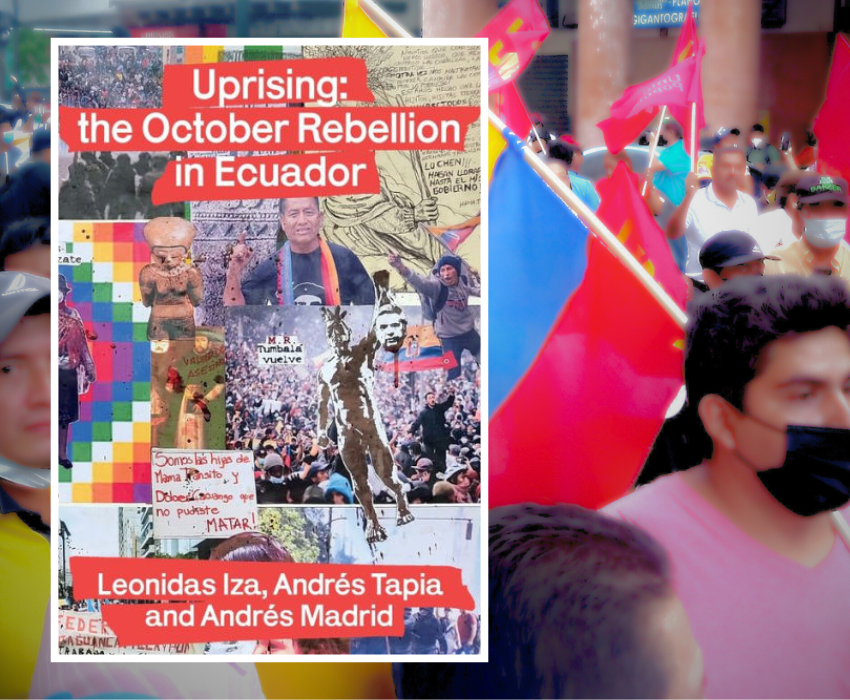
Uprising: The October Rebellion in Ecuador
By Leonidas Iza, Andrés Tapia and Andrés Madrid
Resistance Books & International Institute for Education and Research, 2023
Uprising: The October Rebellion in Ecuador is an exceptional look at Ecuador’s October 2019 anti-neoliberal insurrection from the perspective of one of its central leaders.
Co-written by Confederation of Indigenous Nationalities of Ecuador (CONAIE) president Leonidas Iza, the book vividly recounts — with the aid of numerous stunning photos — those electrifying 11 days that shook Ecuador.
Importantly, it also collectivises the lessons drawn by a key protagonist from this “laboratory for understanding the direction of Ecuador’s social transformations”.
The immediate trigger for protests was a fuel price rise decreed by then-president Lenin Moreno on October 3, 2019. But, as the book explains in detail, the rebellion can only be understood within the broader context of capitalist crisis of accumulation, generalised “loss of confidence in state institutions”, “permanent, silent and uneven escalation of conflicts” and CONAIE’s decisive intervention.
This combustible combination underpinned the remarkable explosion of peoples’ power that ensued and expanded “well beyond the state’s capacity to respond”.
Over the next few days, protesters took over public institutions, governors’ offices, several large public and private companies, and more than two dozen oil fields. They also occupied the National Assembly, “questioning, momentarily, the legitimacy of those who claim to represent the people”.
Recounting these and similar examples of peoples’ power, the authors argue that “the State lost control for eleven days” as a “power parallel to that of the ruling classes emerged”.
Unfortunately, though, the rebellion was not strong enough to provoke a “fracturing of the ruling class” or “its loss of the leadership of society ... Still far from reaching the depth of radicalisation needed for the subversive cause”, the authors conclude: “This was not yet a revolution…
“Perhaps more achievements were possible … however, the excitement at one of the most decisive social events in the history of Ecuador, at certain moments, caused short-sightedness....
“The important thing,” the authors maintain, “is to learn the lessons received and to be sufficiently self-critical to push the projects of the people towards the achievement of better preconditions for living”.
One clear lesson they focus on is that “mass mobilisation was the central feature of the negotiations and confrontations with the state and the ruling class, and the key to understanding the direction taken by the October rebellion”.
Yet, the inability to go further, indicates the need for “an organisation of the exploited classes with a more organic capacity to mobilise, both in the city and in the countryside”.
They also delve into the concrete challenges they identified in terms of mobilising and organising different sectors.
For example, they probe the deep atomisation and demoralisation of the worker’s movement, noting that more than half of Ecuador’s workers are in the informal sector and most in the formal sector remain remote from existing union structures.
Similarly, they unpack the complexities of an increasingly heterogeneous Indigenous movement that has emerged due to “migration to cities, agro-industry and precarious self-employment”. Together with generating new demands, these new realities have sharpened class contradictions within the movement.
Another important area of reflection is the differences between recent protests and those led by the Indigenous movement in the 1990s.
The new protest movements, they write, are in many respects “the children of [that] first uprising”, but differ as they “did not emerge to confront neoliberalism, but its bastard brother: State centrism”.
They are referring to the state-driven “neo-developmentalist” policies enacted by former president Rafael Correa (2007‒17), whom they identify as part of the “institutional left”.
Correa’s election “was a historical defeat” for the anti-capitalist left, the authors argue, as his government remained “subservient to the interests of the reproduction of capital, albeit with redistributive and welfare nuances”.
The challenge is, therefore, to forge a new anti-capitalist project capable of transcending the neoliberalism of the institutional right and the “statism” of the institutional left.
Not all readers will agree with such a characterisation of Correa’s government, nor some of the other conclusions drawn in this book.
Nevertheless, Uprising remains essential reading for better navigating the complex new terrain facing not just the Ecuadorian left but its counterparts in the region.